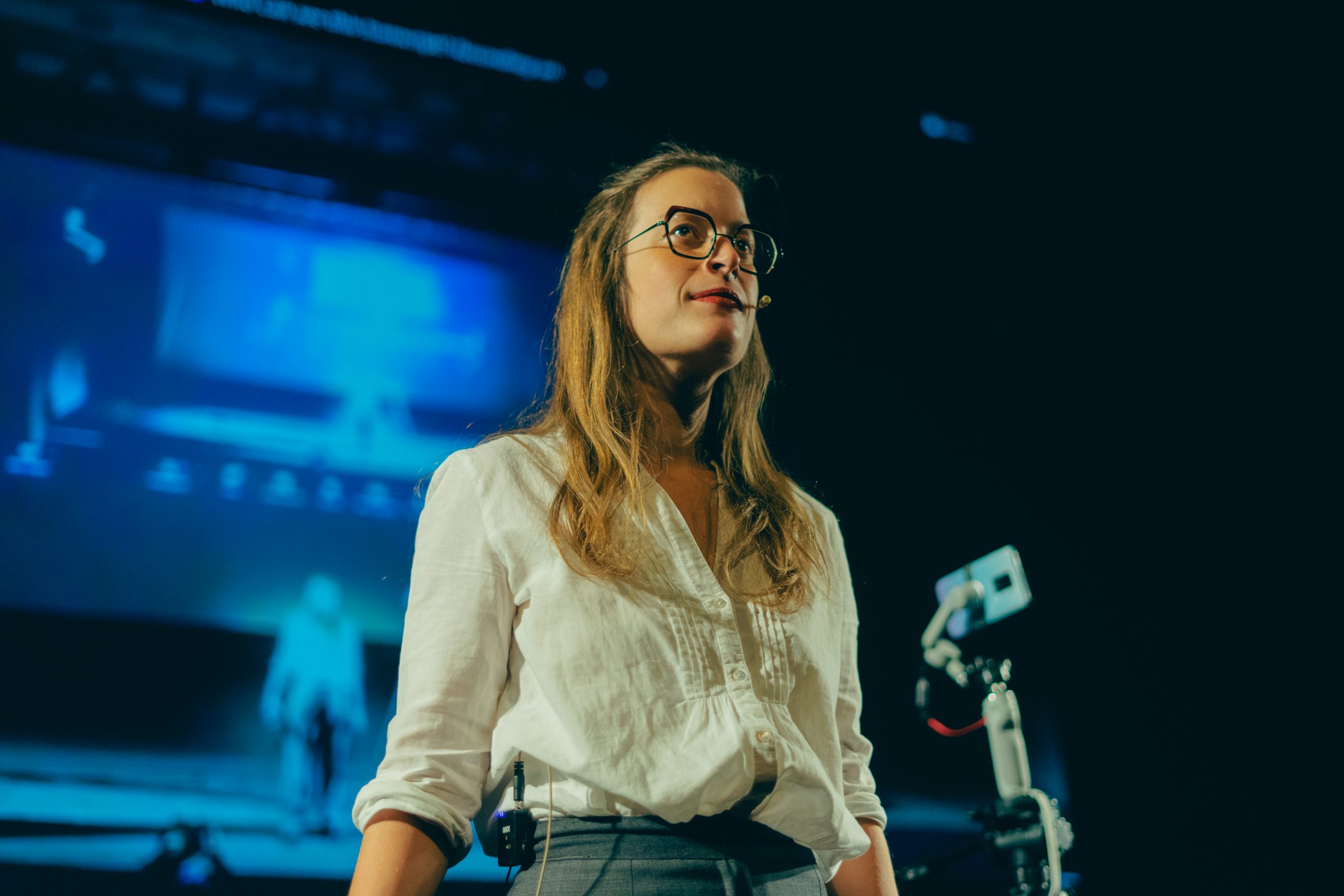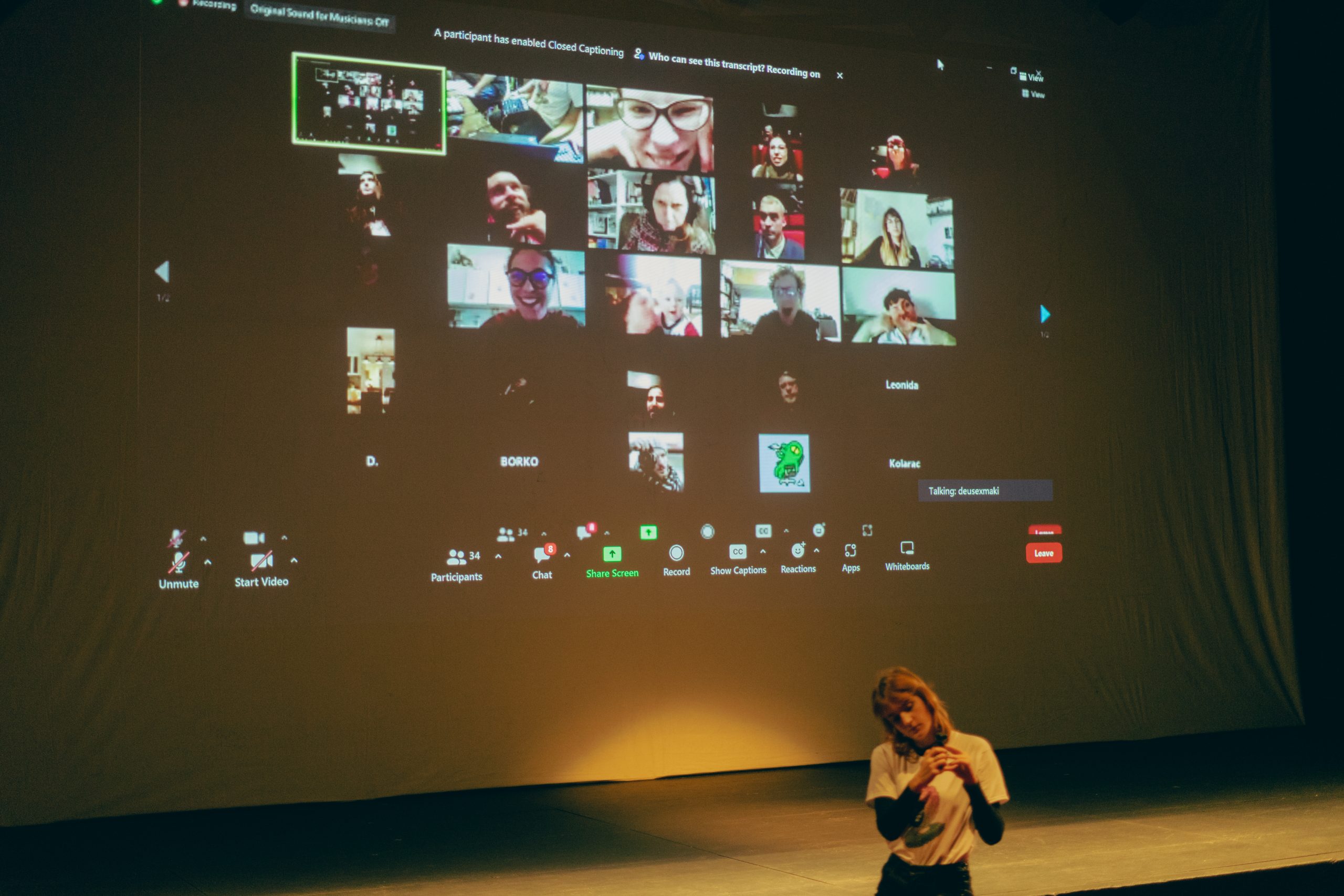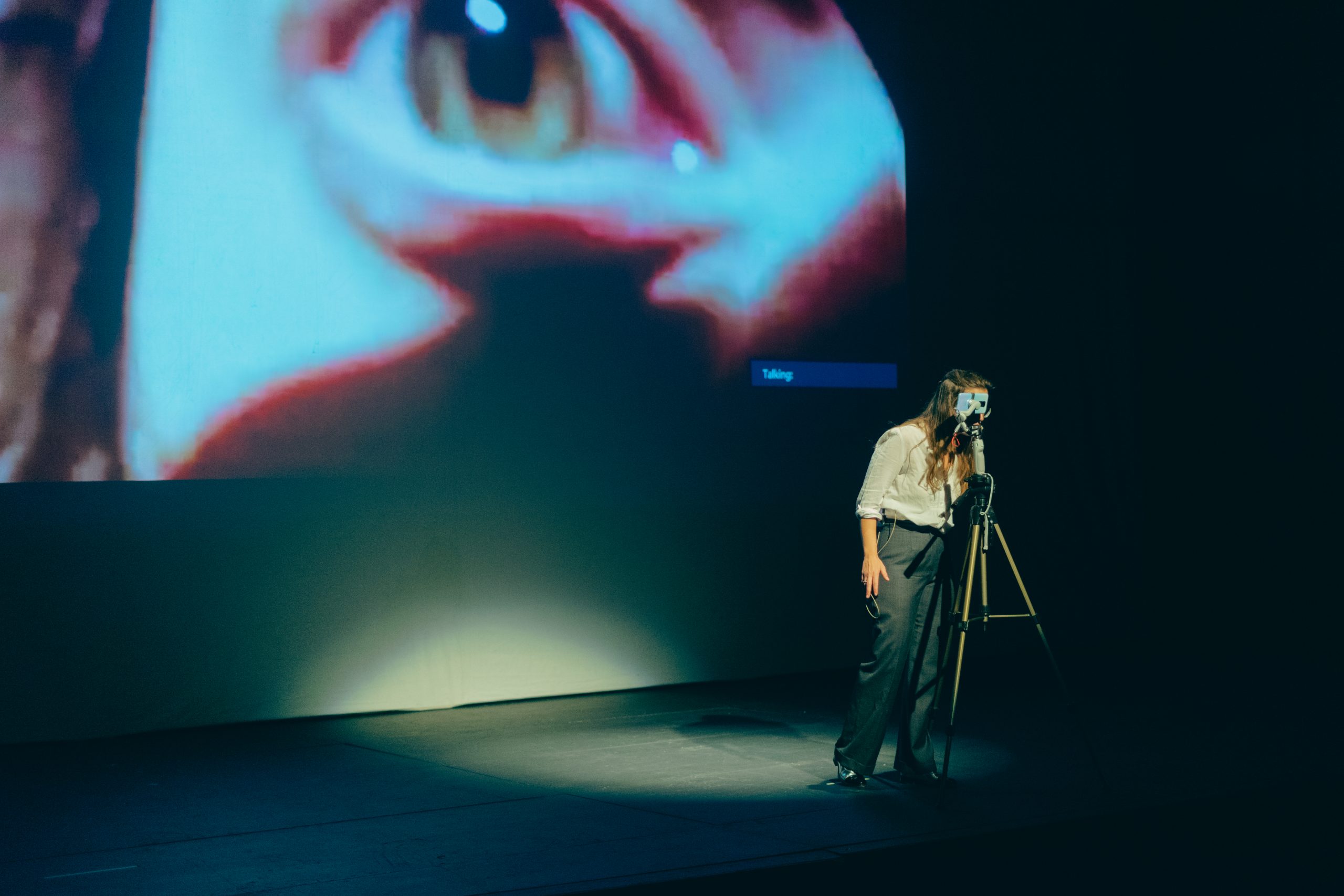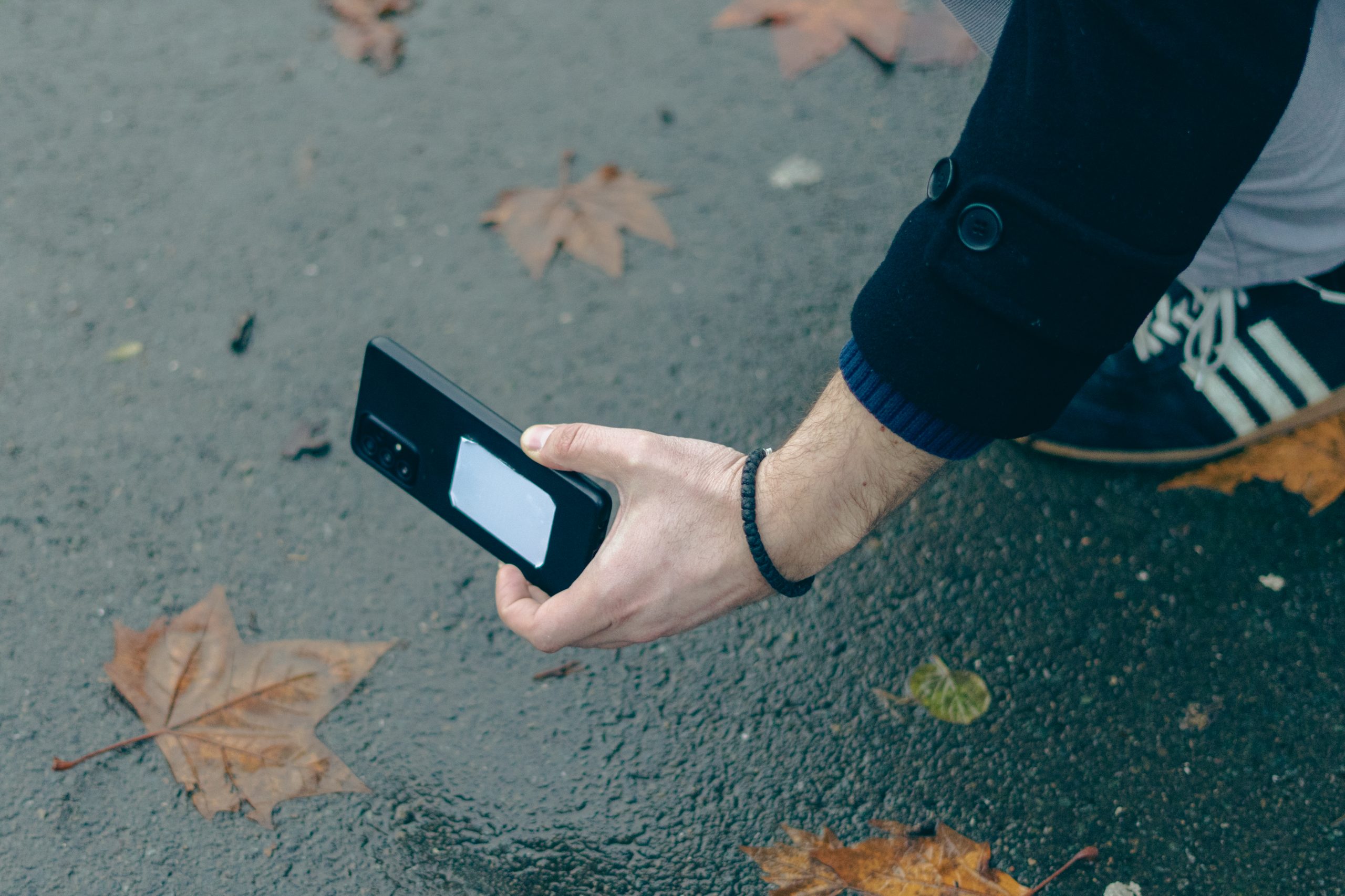Enlarge

This is an auto-poetic text about a hybrid theater performance DeusexMaki (Desibozheizmashine)1The performance premiered on 20 November 2022. It grew out of my Art doctorate at the University of Technical Sciences in Novi Sad, Department of Architecture, Chair of Scene design. by the independent theater group Threepenny (Tri Groša) from Belgrade, Sebia. DeusexMaki was produced using open source and 'found technology'. 'Auto-poetic' means that the author of this text is the author and performer of the performance itself. I will sometimes refer to myself as 'I', sometimes as 'author' and sometimes as 'performer', depending on the context. What is my personal history with internet and what are the circumstances in which this performance came to be? What are the poetic and technical aspects of the performance? Why is hybrid theater important?
Enlarge

Who is Maki
Enlarge

Since this is an auto-poetic text about a hybrid theater piece which is in itself self-reflexive, I believe it is only right to start with the subject in question. For me, the 'Who am I?' question is not about the so-called 'identity politics'. It is a question of responsibility that comes first in every artistic endeavor. It can be rephrased as: Who am I to tell you anything?
Where do I position myself in the relationship with my audience? Where do I position myself within society? How does the system that I criticize benefit me? What gives me the higher ground to express myself in front of a crowd, to lead their perception in the way I chose? After all, digital capitalism and its advertisement politics put us at the center of a crisis of trust. So why would my audience trust me? Why would you trust me?
In the context of digital technology, I am just another user. I have absolutely no special skills in IT. I do not write codes, I do not even use complex digital software to produce my work. I interface only with the very surface of the digital, like most other people: apps – Google – Wikipedia – social media – communication tools.
Enlarge

I come from the extremely analog world of theater, the world of body, physical proximity, and spoken word. I have received classical theater education at an art university in Eastern Europe which I wouldn't call very progressive. Since then, together with a group of like-minded friends and colleagues, I have been running the independent theater group Threepenny. I very much identify with Threepenny, even though we don't have a website. DeusexMaki is our first hybrid performance. Our work is mostly grounded in Belgrade, Serbia.
I was born there, back in 1989. Right at the beginning of my life, I was introduced to the fact that the good days ended yesterday. The country and the system of values that my parents were born into and lived in were falling apart in a bloody and messy way. This narrative follows me ever since. The golden age is over. We live in a stage of permanent crisis.
Enlarge

Enlarge

This same year the World Wide Web was born.2If we take Tim Berners Lee’s Information management: a proposal for the birthday My generation has a special position towards digital technology. For us, it does not have the scent of 'newness', because we were also 'new' when it was a novelty. But when we first became aware of this world, it was still a marginal thing. So, unlike people born after us, we do not take it for granted as we do with the new technologies of some foregone ages (electricity, cinema, home technology).
Not new, but not granted. A position of Brechtian distance.
I was nine when my city was bombed in 1999. At the time my sister was a student in Architecture, in Germany. She was regularly informing us, not without panic, about the German news media coverage of these events. Since then, I suffer from mistrust of the mediated image, and the context constructed around it. One year later the country shifted, with remarkably little violence, from capitalist socialism into socialist capitalism. All the bad things stayed. All the good things were gone. Plus, some new bad things. What, back then in the year 2000, many people believed was a grassroots revolution, was turning out to be a state capture. I was twenty when some travel restrictions were lifted and the so-called 'white Schengen' was introduced to Serbia in 2009. One could at last move freely through most of Europe.
Growing up in an unsafe city - the capital of a country secluded from the rest of the world by sanctions - it is no wonder the internet played a great role in our childhoods. A magical place to reach out to the Other, separated from you with the heavy realities of the world outside your PC. I even managed to meet my first boyfriend in an IRC chatroom, even though we went to the same school. The hobby psychopaths and petty sexual predators were there, but at least they were at a safe distance. Aggression on the web could not compare to the violence of reality.
An excerpt from the text of the performance:
Ever since my adolescent self was discovering the magic of the early internet on forums and IRC chats, the web and the theater seemed to me to have a lot in common. Both of these mediums shatter the borders between the personal and the public, intimate and social, general and particular. Both theater and the internet demand individual engagement, but are only possible in a community. And yet they grew to be so different in their positioning towards the Other (and there is no Self without the Other). The theater is concerned with otherness by default, just looking at the text – director – actor – text – audience relation. The media is highly human, and as such, it is very much about confronting otherness. The dialectics of the dialogue is in the shifting perspectives of the dramatic conflict, in which both sides are 'righteous' in their way. The internet on the other hand has become a place extremely hostile to the expression of otherness. Just look at the richness of terms: on the internet, the Other can be blocked, unfollowed, unfriended, hidden, paused, banned, canceled, unsubscribed, ignored, filtered, etc. Take Facebook: the most options it ever gives you concern the way you want to not see the things that you want to not know about. One could even say that today the internet holds a position that theater had in Ancient Greece: in itself, both in its structural organization and its content, it is an expression of the dominant narrative, but also a place where the ones in power can feel the pulse of the masses. It is the most powerful medium because everybody goes there – freemen, women, children, aristocrats, and slaves. It presents a micro-picture of the macrocosm: not so much of the universal laws and justice, but of the structure of the soft power within a society.
DeusexMaki
How to Make a Multilayered Hybrid Interactive Lecture Performance in a Godforsaken Place like Serbia?
Enlarge

The choice of using what I will call 'found technology' is one of clear Nietzschean amor fati. There is very little to zero structural support for artists working with new media or new technologies in Serbia. This project was financed through a modest grant from the Ministry of Culture for independent theater, ticket sales, and donations. Altogether it amounted to something around 5000 €. Around 60 % went to the people and around 40 % to acquiring gadgets and access. I find this ratio still too much in favor of gadgets and access.
Whilst being paid by taxpayers to do elitist shit, I find it important to give the few that will actually participate in the performance what I believe is what the majority would (or should) want from theatre: enlightened entertainment. The imperative, therefore, was: make it as user-friendly as possible.
So we needed to minimize the technological costs of a techno-heavy performance. To do that we re-purposed the software and hardware already found at hand, without changing its inherent nature imposed on it by its creators. That is what I mean by 'found technology'.
Enlarge

Drawing from my own relationship with technology, I wanted the audience to feel at ease with the gadgets and apps in use. Therefore, they needed to use their personal mobile phones, and preferably their own cellular data. I wanted to avoid the trap of a 'gadget show' in which the novelty of the media steals the limelight. My novelty ambitions were aimed at myself, at novelty in theater, not in technology.
The term 'gadget show' and the warning about it were brought to my attention by Bill Aitchinson, art researcher, performance-maker, and professor at the University of Xiamen, China. We had a mentoring session within a project-development workshop Earth stations organized by a Croatian theater group Shadow casters. The latter has more than twenty years of practice in an interactive, experimental, and primarily sight-specific theater. Sight-specific means that you work with a found space as your stage. In a sight-specific performance, the space is always more than mere scenery. Say you make the same show in a factory and a library – the context of the space is going to change the meaning of the play, not just its visible appearance. But, in turn, your performance will also recontextualize the space itself. As sight-specific performance recontextualizes found space, I wanted to recontextualize found technology. To introduce Brechtian distance to the hardware and software we use every day.
What does a Multilayered Hybrid Interactive Lecture Performance look like?
I, as both the author and performer of the piece, use my Self as the content of the performance. Hence, DeusexMaki is about identity and technology. It is a hybrid interactive lecture performance. It is dealing with transformations that everyday use of digital communication tools is bringing upon my artistical, social, political, metaphysical, and intimate Self.
In this self-reflective and meta-medial piece, I am using everyday user-friendly technology to talk about everyday user-friendly technology. Through this self-referential loop, I am exploring the potentials and limitations of the hybrid format, since I believe that we do need new forms of theater to communicate the new experience of the human condition.
For some demystification: DeusexMaki is a hybrid performance in the sense that it happens both live-in-flesh and live online. It has two groups of audience: one that is on the spot with the author-performer (group A), and the other which is online (group B). Both of these audiences and the performer are present in a Zoom conference call. The performer is always present in an auditory manner, as the lecture is being delivered through Zoom.
The presence of the performer and group A is continuously visually mediated with a) the camera of the author-performer, b) the camera of a volunteer, and c) the cameras of the audience members. The presence of group B is occasionally mediated with their cameras. Camera signals are combined and manipulated live from a home studio, and the output is streamed into Zoom. No special hardware or software was built or acquired for this performance.
The performance takes place in multiple spaces sequentially, and in the in-between. The performer is guiding the audience group A through them. Group B follows this walk over Zoom. Each space marks an aspect of the Self. The performance starts in a theater, where the performer analyzes the implications of digital technology on her artistic Self; it continues on the street where we dive into the world of mediated social Self. The author and the audience split ways in front of an H&M which marks the passage into the political Self. The next station is an art cinema where we explore the metaphysical Self, and then we proceed to a park where we enter the realm of past and future memories – what constitutes our digital intimate Self. Every performance ends in a discussion in a bar.
Enlarge

In this sense, the performance follows a very basic narrative arc: we enter ever deeper into the identity of the author, or at least the aspects of the identity that can be mediated and preserved on the internet.
Enlarge

This performance was created during and in the aftermath of the Covid pandemic. During the pandemic, Zoom became one of the most relatable pieces of software across continents, generations, and social gaps. As a massive system, it is reliable and stable - key features of technological support for any live performance. All the potential malfunctions and bugs within the system are already known to the audience, which makes the lagging funny rather than stressful. Its 'video conferencing' set of tools presents a way to capture the mesmerizing and yet incoherent recontextualizing power of the mediated image. Zoom represents/stands for/plays a role of the 'everyday user-friendly technology' in the performance.
So, if Zoom is so important, why not play the whole performance entirely through Zoom?
Why go 'hybrid'?
Since this is a performance about identity and technology, it is essentially about relations and roles. Relations and roles are dynamic structures, hard to recontextualize; you are too engaged in them to observe them. They are performative. To recontextualize you need a certain distance – a Brechtian distance. The famous 'Verfremdungs effekt'3The alienation/distancing effect: a technique used in theater and cinema that prevents the audience from losing itself completely in the narrative, instead making it a conscious critical observer.. You understood it correctly – I wanted to make the experience anti-immersive.
Enlarge

How do you introduce estrangement to Zoom? Simple: by using it unconventionally.
How do you introduce estrangement to one's interaction with Zoom? By making it observable to Others.
It is only in the presence of an audience that one can perceive his/hers actions as performances and his/hers own Self as performative. That is why two groups of the audience are necessary – the performer/follower/viewer/user borders are shuffled and exchanged and shuffled again. This insecurity of one's role and position in the context of the performance creates a heightened sense of self-awareness in the interaction itself.
Enlarge

To feel initially comfortable, both groups of audience need guidance. I position myself as the author-guide confronting the audience in flesh, voice, and image. Being present in the situation represents, at least for me, an act of taking responsibility. I, as an author, take full responsibility for the possible failure or success of the experiment. You, as an audience, represent the community by legitimating my act through your presence. Are you having fun? The people operating in the studio guide the online aspect: they control the audio-visual image output and lead the Zoom interaction. The people behind the machine represent the soft power of technology – the invisible world of programming, of creating and disembedding circuits. They also get their five minutes of fame in the program. They reshape our act into something collective and machine-transmittable, creating a whole new 'user experience' of the same event for group B.
So – in short words – I am walking a hybrid group of people through my city delivering my thoughts, fears, and ideas about and with online digital technology, illustrating them with in-action examples.
This self-referential hybrid universe is filled with feedback loops and glitches. I embrace them as my sole aesthetics.
(Blurred) Tech-specs
Of course, found technology is not what we find at home, but in any small theater/studio. I, as the main performer, am equipped with a smartphone with unlimited cellular data. The smartphone is enhanced by a stabilizer and a microphone receiver. I have a Madonna microphone with a wireless sender connecting me to my smartphone. The picture is very low quality, whilst the sound is middle to high quality. I find that for us, the YouTube generations, the resolution of the video plays a very minor role – we are used to deciphering the pixels. What we learned from influencers: it is the sound that creates the content, the message. You cannot use your imagination to decipher the inaudible. This (low-quality) image and (mid to high-quality) sound are sent via cellular data to a PC located in the home studio. The software supporting this transfer is Open Broadcast Software and the corresponding OBS Ninja application on the phone. The same application is used to transfer camera B (volunteers' camera) to the home studio. In the home studio, the image is processed using software (OBS and Resolume Arena) and hardware (video-switchers). The sound is processed over a mixer. The processed picture and sound are then fed back into Zoom.
Enlarge

Why is interactive hybrid theater important?
Explaining what Deusexmaki actually is in the sense of genre or even format was extremely difficult. This difficulty is not just one of articulation, but one of labeling, and positioning my art on the market. People are not inclined to buy something they don't recognize – and this goes even more for art curators, whose job is to label and sort your artistic work. Without a label, it does not qualify as art.
Even though in recent years there has been much talk about 'hybrid', 'inter/transdisciplinary', 'fluid', and similar, it seems that art institutions, festivals, funds, and other gatekeepers still find it hard to grasp the variety of art formats that can be produced and the significance of this variety. Institutions, no matter how liberal, are looking for rigid labels. 'New media' stopped being new - it became a name for a certain set of trending art formats.
Creating a theater form that is happening both live-in-flesh and live-online is not just about communicating the new experience of the human condition. At the end of the day, you can do that without ever using a computer.
I try to use the internet in the old-school idealist way: to bypass the gatekeepers.
I live my life internationally. I make and keep more or less superfluous relationships with people all around the world. The trauma of childhood seclusion and global digital capitalism demand this. And yet, most of my friends, colleagues, and contacts have never seen my work. The possibility of an independent theater group from Serbia traveling to Germany is very low. South-America? Even lower. USA? Japan? Indonesia? Non-existent. And even the existing possibilities are shrinking.
Hybrid theater is a way for me to present my work to people all around the globe without feeling obliged to produce work that is trending on the art market. Of course, since DeusexMaki is a unique experiment, the only way to reach a somewhat wider audience is through mouth-to-mouth from your friends and acquaintances. But this is the case with alternative theater, hybrid or not. And I dream that one day, there will be a platform for us as well. A serious digital stage for online or hybrid performances. A place where the audience can find its content and content its audience.
How to label it? Online, perhaps not everybody is a creator, but everybody is a curator. Most of our online activity can be labeled as curating. So, like social media and its hashtags, I approach every audience member as a curator. At the end of every performance, I ask them to label their experience by genre. Here is a short list of the more interesting tags:
#live video podcast #serious stand-up #a cyber road-show #digital street theater #mindblowing trip #a happening #lecture spectacle #intermedia seesaw #ZOOMventure #alternative reality-show
Marija Barna‐Lipkovski (1989) is a theater director, performer and arts researcher. She is exploring performativity as the intersection of everyday life, techno‐capitalism and arts. After finishing her BA and MA studies of theater directing at the Faculty of Dramatic Arts in Belgrade, and spending one year as a DAAD arts scholar in Berlin, Marija found her own theater group Threepenny/Tri Groša. With this group she explores the shifting border between reality and fiction, often using multimedia. Marija has received a couple of prizes for her work, most notably Best director at the ArtOkraina festival in St. Petersburg. She is a research assistant at the Faculty of Technical Science, department for Scene Design in Novi Sad.
- Figures 15, 16 & 17 : Glitches, real and fake. Screenshots
The show has been made possible by Nenad Pinter, David Srbljin, Ana Najkić, Miklós Barna-Lipkovski, Dóra Németh, Ana Pinter, Nikola Radeka. For next performances and questions, feel free to contact us at 3grosa@gmail.com.




